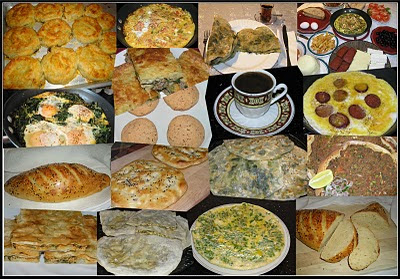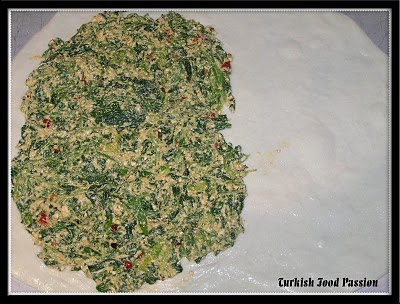According to many culinary experts, Turkish food is considered to be among the top three greatest cuisines in the world along with French and Chinese. Some may agree with the French and Chinese but find the Turkish one debatable. When looking back at Turkish history, the reason for Turkish cuisine being ranked among the top three cuisines in the world can be understood better. Let’s take a look.
Original Turks lived a nomadic life style and migrated from the Far East Asia, (mainly Western China Tibet and Mongolia regions) to the current geographic location of Turkey and surrounding areas. As they moved from the Far East to Asia Minor (current Turkey), the Turkish ancestors adopted various foods from various cultures along the way which led to a very diverse although developed and refined cuisine. For instance, ‘mantı’ which is small pieces of dough stuffed with minced meat and spices topped with yogurt sauce is supposedly adopted from Chinese dumplings. It is said that the idea of ‘dolma’ (stuffed vegetables) came from ‘mantı’. Due to their nomadic lifestyle, the nomadic Turks’ diet was mainly based on animal products such lamb, goat and game. Different techniques of preserving food were invented in order to prevent food from spoiling. Perhaps ‘pastırma’, which is dried cured beef mainly made in the city of Kayseri in Cental Anatolia region came about from the need to preserve meat without spoiling. It is no secret that the integration of nomadic Turks with other civilizations, geographic locations and weather had influenced their culinary traditions which brings us to food culture of the Ottoman Empire. The vast Ottoman Empire which covered three continents for a length of almost 600 years and controlled the spice road, influenced food culture from North Africa to Eastern Europe (up to Vienna, Austria) and most of the Middle East leaving a trace of similarities in the current Mediterranean, Eastern Europe and Middle Eastern cuisines. The Imperial Palaces had enormously large kitchens that had separate cooks for each kitchen specializing in one single type of dish that was developed and perfected over time. For example, each cook specialized in ‘pilav’ (pilaf), ‘dolma’, ‘baklava’, ‘kebabs’, ‘desserts and so on. Dried fruits such as apricots, raisins, currants and the best quality spices frequently were employed in cooking. Through development and improvisation, the Ottoman Cuisine evolved to be the current Turkish cuisine. After the end of Ottoman Empire, the modern Republic of Turkey was founded in 1923 adopted the same delicious cuisine and cooking techniques.1
The importance of food during the Ottoman days and now in the current Republic of Turkey cannot be overstated. It is a significant part of the culture and daily life. This solid sense of food culture can be found in every single part of Turkey albeit the food itself is very heterogeneous. Although some dishes are prevalent throughout Turkey, every region, even province has its own type of cuisine that may not be recognized by other regions.
Almost every region or province is renowned with one or more types of foods. The South/Southeast region encompassing mainly
Adana,
Mersin,
Hatay,
Gaziantep,
Kilis,
Şanlıurfa provinces is known for its spicy and versatile foods. Red pepper paste and many types of spices are frequently used in its food such as ‘
kısır’, ‘
dolma’, ‘
kebaps’, ‘
stews’ and many other dishes to enhance flavor of a dish. Mersin is known for its ‘tantuni’ (sauted minced meat with spices placed inside bread), Antakya is renowned with its delightful dessert ‘
künefe’, Adana with ‘
Adana kebap’, Gaziantep with ‘
baklava’, ‘antepfıstığı’ (pistachios), Şanlıurfa with ‘çiğ köfte’ (fine bulgur mixed with raw ground meat and spices) and Central Anatolia with ‘keşkek’ (meat and wheat or barley stew). When ‘hamsi’ (anchovies) is mentioned, the first place that comes to mind in Turkey is the
Black Sea region which is located in Northern Turkey. This area is also known for its ‘kara lahana’ (collard greens) dishes, black tea and hazelnut farming.
Kayseri province which is in the Anatolian region is known for the best ‘mantı’ and ‘pastırma’ (pastrami). The
Mediterranean region in southern part of the country and
Aegean region in the west part of the country are popular with vegetable and olive oil dishes and the list goes on.
The variation of Turkish food from region to region is as a result of a diverse weather, lifestyle due to geographic location and ancestry. Turkey is composed of people from different ancestries who carry on their food traditions for centuries allowing a wide range of foods to be served in Turkey. Thanks to the diverse weather, numerous types of crops grow in Turkey enabling a rich cuisine to form. The wheat farming that started with the nomadic Turks for centuries has given a focus on doughy foods such as ‘
ekmek’ (bread) which is a main staple throughout the country, ‘
böreks’ (stuffed pastries) and ‘
bulgur pilafs’. Due to proximity to the seas, fish and other seafood are a crucial part of the Mediterranean, Aegean,
Marmara and Black Sea region diets.
The foundation of Turkish food is based on the freshness of the ingredients. In rural areas the vegetables come right out of people’s garden just before cooking, the meat comes from a farm or local butcher. As society changes and more and more women participate in the work force, naturally many urban dwellers are adapting the modern conveniences eagerly leaving behind some of the food traditions. Although, there are still some people who are living in cities and perform the routine of grocery shopping daily to get the freshest available ingredients. In smaller cities and less populated areas, fresh ingredients are still the biggest factor in cooking.
Some of the main ingredients used in Turkish food can be stated as follows:
Tomato paste, red pepper paste, pomegranate molasses, olive oil, yogurt, olives, cheese, cumin, sumac, red pepper flakes, paprika, black pepper, lemon, oranges, parsley, mint, dill, garlic, onions, tomatoes, green peppers, eggplant, zucchini, green beans, cucumber, cabbage, fish, chicken, beef, lamb, yufka (phyllo dough), kadayıf (shredded phyllo dough), chick peas, dried beans, lentils, pistachios, walnuts, hazelnuts and almonds.
Turkish food can be divided into the following groups:
1) Mezeler (Appetizers)
2) Dolmalar (Stuffed vegetables with rice or meat)
3) Çorbalar (Soups)
4) Salatalar (Salads)
5) Baklagiller (Legumes)
6) Zeytinyağlı Sebzeler (Olive oil vegetable dishes which are usually served cold)
7) Pilavlar (Rice or bulgur pilafs)
8) Etli Sebzeler (Vegetables with meat)
9) Börekler (Stuffed pastries with meat, cheese or vegetables)
10)Pideler (Flat bread with cheese, meat or vegetables)
11)Kebaplar (Kebaps which range from kebabs cooked in a pot to skewered kebaps)
12)Balık ve Deniz Ürünleri (Fish and other seafood items)
13)Tatlılar (Desserts)
14)İçecekler (Drinks such as Turkish coffee, Turkish tea, rakı, ayran)






 Turks love eating and relishing food. As a result, feast-like meals are not out of the ordinary in a Turkish home. If you are present in a Turkish home for breakfast, lunch or dinner, the variety and the effort put into preparing the table will be very evident. In Turkey, having people over for dinner or a tea party is a very common and frequent tradition which involves socializing. It is part of the society, the culture and tradition.
Turks love eating and relishing food. As a result, feast-like meals are not out of the ordinary in a Turkish home. If you are present in a Turkish home for breakfast, lunch or dinner, the variety and the effort put into preparing the table will be very evident. In Turkey, having people over for dinner or a tea party is a very common and frequent tradition which involves socializing. It is part of the society, the culture and tradition.
Note: If you live in Houston or surrounding areas and interested in Turkish food or culture, there will be an annual Turkish Festival taking place on October 16-17, 2010 that will have delicious food, music, dancing and etc. This is sponsored by the American Turkish Association of Houston which is a non-profit organization. For more info visit the following website: http://www.turkishfesthouston.com/ 1- Republic of Turkey Ministry of Culture and Tourism, Culinary Culture
 Katıklı ekmek is very popular in Antakya, Turkey. Some stuff the dough with spinach and çökelek mixture and some spread this mixture on top of a thin sheet of dough. The preparation of the dough is different than mine because in Antakya, Turkey, the mixture is sent to a bakery and the dough from the bakery is used. Then, it is baked in the wood ovens in the bakery which gives the bread/borek a very distinct and wonderful texture and flavor.
Katıklı ekmek is very popular in Antakya, Turkey. Some stuff the dough with spinach and çökelek mixture and some spread this mixture on top of a thin sheet of dough. The preparation of the dough is different than mine because in Antakya, Turkey, the mixture is sent to a bakery and the dough from the bakery is used. Then, it is baked in the wood ovens in the bakery which gives the bread/borek a very distinct and wonderful texture and flavor. Wash the spinach thoroughly so that there is no dirt in the leaves. Boil water in a large pot. Place the clean spinach leaves in boiling water for two minutes and remove. Immediately, run cold water over the spinach to stop the cooking process. Squeeze all the water out of the spinach. Chop the spinach coarsely.
Wash the spinach thoroughly so that there is no dirt in the leaves. Boil water in a large pot. Place the clean spinach leaves in boiling water for two minutes and remove. Immediately, run cold water over the spinach to stop the cooking process. Squeeze all the water out of the spinach. Chop the spinach coarsely. Crumble the çökelek onto the spinach.
Crumble the çökelek onto the spinach. Add the salt. Set aside.
Add the salt. Set aside. Place the stuffing one side of the dough and cover it with the rest of the dough.
Place the stuffing one side of the dough and cover it with the rest of the dough.
 The dough will stretch and the stuffing will become visible from the outside of the dough. Repeat this process for all eight pieces of dough. Brush some olive oil on top of these pockets.
The dough will stretch and the stuffing will become visible from the outside of the dough. Repeat this process for all eight pieces of dough. Brush some olive oil on top of these pockets.




























